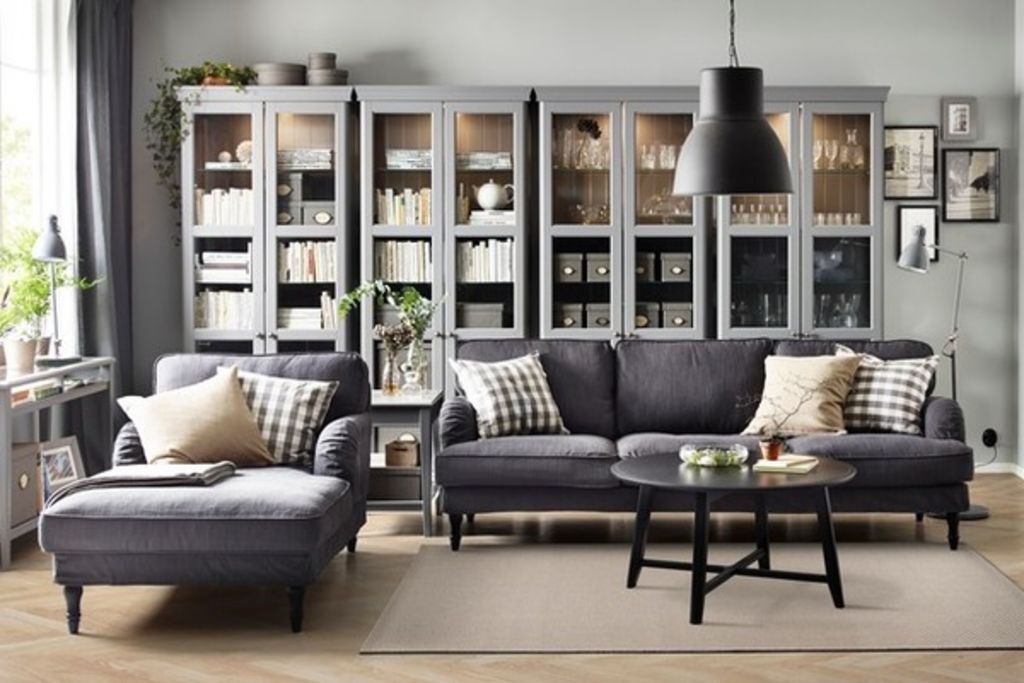No it's not your imagination, our furniture is getting bigger

Author: Елена Игумнова
Size and scale in furniture mean more than just harmony of proportions: they are first and foremost a matter of practicality. The height and depth of a sofa can determine how comfortable a family feels when spending time reading or watching movies. A chair back that’s too low can disrupt meal and work times, while awkwardly tall kitchen cabinets can spoil the fun of cooking dinner.
The pioneers of Modernism looked into proportion and people’s interactions with space, and applied their findings to furniture design. The famous Modulor Man anthropometric scale of proportion, developed by Le Corbusier, offered a standard of sorts and served as a guideline for furniture manufacturers. But average human height has increased over the decades, and furniture proportions have changed accordingly. Find out how furniture makers are adjusting their offerings to provide us with more flexibility and choices.

How it used to be
From ancient times until the Renaissance there were no standardised measurement systems: the human body was used as a standard. The system of feet and inches originated from these simple and easily accessible body measurements. A foot was the average length of a human foot; an inch was the length of the top phalanx of a thumb; a yard was the length of a step or of a man’s outstretched arm measured from the middle of his body.
The metric system was more abstract and came into wide use thanks to the French Academy of Sciences, which in 1791 defined a metre as 1/10,000,000 of the distance between the equator and the North Pole, measured via Paris.
Modernist standards
The discrepancies were so great that they would become stumbling blocks to experts from countries with different measurement systems. The contradictions and mismatches were ironed out in the mid-20th century by one of the fathers of Modernism, Le Corbusier.
Le Corbusier developed a new system, the Modulor, describing it as “a range of harmonious measurements to suit the human scale, universally applicable to architecture and to mechanical things.” The Modulor initially was based on a man’s height of 1.75 metres, and was changed to 1.83 metres in 1946.
Le Corbusier wanted to breathe harmony into the stream of products manufactured worldwide, making his system less of a canon and more of a convenient tool to use.
“Sometimes,” he said, “I have seen on the drawing boards designs that were displeasing, badly put together: ‘But it was done with the Modulor.’… If all you can do with the Modulor is to produce such horrors as these, drop it. Your eyes are your judges, the only ones you should know.”

Time to grow
“Human beings’ measurements have changed considerably over the past centuries, especially in the last one,” says designer Marco Piva of Studio Marco Piva. “I’m thinking of Napoleon’s bed or Emperor Franz Joseph’s in Austria’s Schönbrunn Palace, very small when compared to the current ones, yet only two centuries have passed. In general, statistics show that, since the beginning of the 20th century, people are much taller in Europe. This is a significant change, although I don’t think it’s had a profound effect on the design world.”
In Piva’s opinion, what’s really changed is the way in which contemporary humans live in their own spaces and feel at ease in them. “There has certainly been a general resizing of objects, accompanied by technological breakthroughs on their possible use, but I think this has happened in the general perspective of the individual’s wellbeing and comfort.”
Over the past 50 years, the average human height has increased worldwide by nearly 10 centimetres, according to Swiss design company Vitra. This led the trendsetting furniture maker to conclude that tall people may feel uncomfortable sitting in its Eames Lounge chair (pictured), as they may find the 20th-century classic a bit too small.
Updated classics
“In 2010, the company made a decision to supplement the original 1956 Lounge chair with an upsized version,” says Margarita Morozova, a Vitra spokeswoman. “Vitra’s decision was dictated by the way Charles and Ray Eames, the creators of the chair, understood design.
“They compared a designer with a good host, whose job was to accommodate and pretty much indulge their guest,” Morozova says. “It was common practice at the Eames office to review product design, even when the product itself had been sent for manufacturing, and adapt it to new requirements, as long as the move was useful and justified.”
Browse more mid-century modern designs
The new version of the Eames Lounge chair has a longer seat and arms and a taller back. Apart from these extensions, the size, build and materials have remained the same.
“At first glance, the new edition is hardly different from its original version,” which continues to be available, Morozova says. “The difference is hard to spot with the naked eye, but you can feel it once you’ve sat in both chairs.”
Vitra continued to update its 20th-century designer pieces and in 2015 reissued the iconic Eames Plastic chair. People had pointed out that the chair was too short compared with most modern tables and chairs.
“The company has increased the height of the seat by 20 millimetres and made some changes to its geometry,” says Edwin Gugerell of Vitra International. “While visually subtle, these changes make the chair much more comfortable, especially when used with modern tables.”

Changing times
“For the most part, furniture dimensions have been transforming due to changes in social and market demands,” says Victoria Baryshnikova of the German Furniture Union, Premiumwerk. “One hundred years ago, neither the Thonet Brothers nor WK Wohnen would have thought of including a disclaimer in their chair paperwork: ‘Maximum user weight: 130kg.’ But nowadays, every manufacturer does it.”
Baryshnikova adds, “The weight limit was brought about by new furniture materials and designs. For example, the iconic Modernist D42 chair by Mies van der Rohe and the Wassily chair by Marcel Breuer feature a bent metal tube frame. This kind of frame distributes weight differently from a four-legged chair. That’s the secret behind the change.”
The most dramatic changes in furniture size have occurred over the last three to four centuries, says designer Ivan Veretennikov, of Interiery Extra Klassa.
“Baker Furniture used museum designs to create replicas for one of its collections,” Veretennikov says. “It turned out that 16th and 17th century items tend to have lower seats,” of 37 to 40 centimetres, compared with today’s 45 to 50 centimetre standard.
Previously, any deviations from European or American furniture standards, such as in bed manufacturing, had to be custom-made.
“In the late 1990s, the furniture company Hülsta made a 240-centimetre-long bed for a St Petersburg-based ex-basketball player who was 220 centimetres tall,” Baryshnikova says. “At the time, this was something out of the ordinary, and manufacturers were not prepared to make furniture this size. Nowadays, 210- to 220-centimetre-long beds are commonly offered in the main collections of both premium and lower-end brands.”
Flexible options
Other companies that manufacture furniture also are reviewing their collections, making adjustments for lifestyle and size. Beds are getting longer and wider, while wardrobes are becoming taller.

Ikea made major changes to its kitchen furniture range after conducting ergonomics research. Its new-generation kitchen system Metod is modular. The system’s cabinets, drawers, doors and fronts (pictured) can be ordered in a variety of heights, widths and storage capacities. “The sizes of kitchen cabinets are modular nowadays to fit any space,” says Roy Hesling, country interior design leader at Ikea Russia.
“In the bedroom, as anticipated, the general proportions of beds and mattresses have been considerably enlarged,” designer Piva says. “In the bathroom, the measurement of the bathtub, and especially of the shower enclosure, have expanded.
“Modern humans consider their houses to be not only private havens, but also ‘social’ and more informal places,” Piva says. “As a result, the objects within it are flexible, which I think is the real key word in contemporary design.
“In the design world today, competition has allowed companies to find new solutions to ensure individual comfort, so now you can find a variety of sizes for all furnishings. The same has happened in the fashion world: if 20 years ago it was almost impossible to find size 41 [Australian size 10] shoes (and not because there was no one with size 41 feet), it’s now easy,” he says.
“Design and fashion feed the needs of modern man, and on this basis create a much larger range of possibilities.”
Big or small?
The standards introduced for furniture at the time of Le Corbusier still apply: the recommended height of a dining table is 72-78 centimetres (from the floor to the top corner of the tabletop); the standard seat height is 40-45 centimetres for chairs (from the floor to the seat) and sofa height is 42 centimetres.
Most furniture manufacturers have expanded their size range and choices. We no longer have to put up with a narrow bed or sustain knee injuries from kitchen cabinets. Thanks to a variety of sizes and a modular approach to furniture building, it’s now easier to find the right item for every member of the family, however big or small they are.
We recommend
We thought you might like
States
Capital Cities
Capital Cities - Rentals
Popular Areas
Allhomes
More







